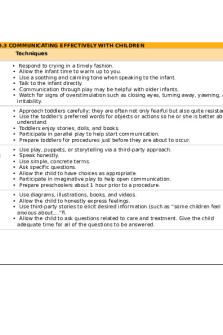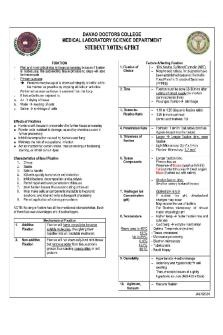Dynamics and Expressive Techniques PDF

| Title | Dynamics and Expressive Techniques |
|---|---|
| Course | Music: Music 1 |
| Institution | Higher School Certificate (New South Wales) |
| Pages | 3 |
| File Size | 326.2 KB |
| File Type | |
| Total Downloads | 12 |
| Total Views | 151 |
Summary
Helpful when reviewing for Music 1 Aural exam and aural practices...
Description
DYNAMICS & EXPRESSIVE TECHNIQUES. What are dynamics? Dynamics are the graduations in the volume of sound, from loud to soft, in a piece of music. Dynamics also describe featured changes, such as a gradual increase or decrease in loudness, contrasting volumes and emphasis on particular sounds. Dynamic levels and changes are often indicated using Italian terms — for example, pianissimo (meaning ‘very soft’), fortissimo (‘very loud’) and crescendo (‘gradually becoming louder’). What are expressive techniques? Expressive techniques refers to the musical detail that articulates a style or interpretation of a style. They are the details and additions that a composer or performer applies in a piece of music to enhance its style. For example, an expressive technique for an electric guitar is the use of distortion to convey a rock music style.
Expressive techniques and dynamics are linked. Without attention to these features, music can lack interest and variety.
DYNAMICS:Dynamics are the volume of sound, and when discussed we are analysing this volume of sound and the effects it has on the music: Show loud or soft the music is How the volume changes during the piece Where the emphasis (accent) is placed on particular sounds The impact the volume has on the music. Composers may use terms and markings on their music to express relativevolume levels or changes in volume levels. The development of dynamics in Western art music through the centuries and different musical periods is more straightforward than some other developments in music. In musical styles of the medieval period (about AD 500 to 1400) and the Renaissance (1400 to 1600), dynamics were not a significant feature. Volume levels were generally even throughout a piece. The Baroque period (about 1600 to 1750) saw the beginning of the use of dynamics in music, but only in terms of loud and soft (terraced dynamics). Terraced dynamics are a distinct feature of Baroque music, owing mainly to the limitations of the keyboard instruments of the time. The Classical period (about 1750 to 1820) and its composers, such as Wolfgang Amadeus Mozart (1756–1791) and Franz Joseph Haydn (1732–1809), used soft and loud dynamic levels and also explored gradual changes between volume levels (becoming louder or becoming softer). ore dramatic, with composers ds. ries, composers and performers g exploring the extremes of dynamic yd ucti (la wit ,w
DYNAMICS & EXPRESSIVE TECHNIQUES.
EXPRESSIVE TECHNIQUES: Expressive techniques refer to the way a performer plays a piece of music. The composer indicates specific details and techniques to guide the musician’s performance which are directions to help portray the style of the music. Expressive techniques are coupled with dynamics; without these features to give a variety of ‘shades’ to a piece of music, it would sound quite unexciting and plain. A wide range of expressive techniques have been developed over time. They mainly relate to tempo, style, articulation, ornamentation, instrumental and vocal techniques, and electronic manipulation. Many of these features overlap in meaning. Music scores can contain many specific terms that identify expressive techniques.
COMMON TERMS USED:Pianissimo Piano Mezzo piano Mezzo forte Forte Fortissimo Crescendo Diminuendo Sforzando Subito Terraced dynamics Forte-piano Dynamic swell Legato
Very soft Soft Moderately soft Moderately loud Loud Very loud Gradually getting louder Gradually getting softer With sudden emphasis Suddenly Loud and soft elements in a piece of music with no graduations Notes attacked loudly, then immediately soft To increase or decrease gradually in volume Smooth and well detached
DYNAMICS & EXPRESSIVE TECHNIQUES. Accent Vibrato Marcato Tremolo Tenuto Glissando Arco Pizzicato Spiccato Finger picking Mute Strummed Double stopping Slap Pop Pitch bend Palm mute Drum roll Flutter tonguing Distortion Delay Echo Scat singing Slur Doink Ornamentation Harmonics Sul ponticello Con sordina Senza sordina Acciaccatura
Appoggiatura Rubato Ritenuto Fermata
Sudden emphasis on a note or notes Vibrating, quivering or shaking on a note Marked A rapid repetition of the same note Held for their entire value A slide from one note to another With the bow Pluck the strings with a finger Light staccato achieved by the bow bouncing off the strings Pick the individual strings A device placed on the bell that dampens or alters the sound of the instrument Scraping the hand across the strings of the instrument to produce a sound Playing two notes at the same time Usually related to the bass guitar, when the musicians hit the strings with such emphasis to produce a note Pulling the strings and releasing so that is drops and ‘pops’, almost like a forceful pluck. Making a note temporarily sharp or flat Plucking the strings with the fingers while the damping is in effect Rolling effect caused by rapid left and right strokes on a drum. A rapid movement, creating a flutter, usually an ‘r’ sound Changing the sound so it is distorted, usually through an effects pedal or amplifier A repeat of a sound or sounds A musical tone produced by the reflection of an impulsive sound Improvised ‘nonsense’ syllables that are sung Two different notes are joined creating a smooth effect Sliding upwards in pitch at the same end of a note Musical decoration (Eg:- trills, mordents, accents etc.) Creating multiple tones off an original note Playing on the bridge With mutes Without mutes A ‘crushed’ note; a note played at the same time as, and crushed into, the following note, where the time value and length of the note does not change. A ‘leaning’ note; a note played which leans into the next note, taking some of its note value With freedom; robbing the time Held back, immediately slower A pause...
Similar Free PDFs

PERT AND CPM Techniques
- 66 Pages

Chapter 13 – Expressive Culture
- 5 Pages

Coaching Model and Techniques
- 5 Pages

COUNSELING SKILLS AND TECHNIQUES
- 7 Pages

Ch 7 Tempo and Dynamics
- 5 Pages

Group dynamics and Team Cohesion
- 9 Pages

Kinematics and Dynamics Chapter 7
- 21 Pages
Popular Institutions
- Tinajero National High School - Annex
- Politeknik Caltex Riau
- Yokohama City University
- SGT University
- University of Al-Qadisiyah
- Divine Word College of Vigan
- Techniek College Rotterdam
- Universidade de Santiago
- Universiti Teknologi MARA Cawangan Johor Kampus Pasir Gudang
- Poltekkes Kemenkes Yogyakarta
- Baguio City National High School
- Colegio san marcos
- preparatoria uno
- Centro de Bachillerato Tecnológico Industrial y de Servicios No. 107
- Dalian Maritime University
- Quang Trung Secondary School
- Colegio Tecnológico en Informática
- Corporación Regional de Educación Superior
- Grupo CEDVA
- Dar Al Uloom University
- Centro de Estudios Preuniversitarios de la Universidad Nacional de Ingeniería
- 上智大学
- Aakash International School, Nuna Majara
- San Felipe Neri Catholic School
- Kang Chiao International School - New Taipei City
- Misamis Occidental National High School
- Institución Educativa Escuela Normal Juan Ladrilleros
- Kolehiyo ng Pantukan
- Batanes State College
- Instituto Continental
- Sekolah Menengah Kejuruan Kesehatan Kaltara (Tarakan)
- Colegio de La Inmaculada Concepcion - Cebu








